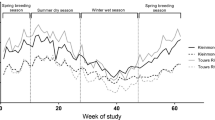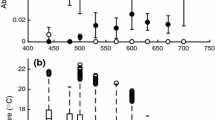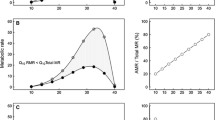Abstract
A common belief is that the body-mass scaling of metabolic rate is the result of intrinsic (physical) constraints related to body design. However, many recent studies have shown that extrinsic (ecological) factors significantly affect metabolic scaling relationships, both within and among species. One of these factors is ambient temperature (T), but its influence on the intraspecific (ontogenetic) scaling slope (b) of metabolic rate varies widely. I tested whether the metabolic-level boundaries hypothesis (MLBH) can explain this variation, at least in part. The MLBH predicts that b should correlate negatively with T for resting metabolism, but show variable associations (from negative to positive) for metabolism measured during varying levels of locomotor activity. I tested the MLBH by using a literature survey of T effects on b for resting or routine metabolic rates of 179 animal and plant species. As predicted, sedentary species of ectothermic animals and plants exhibiting no locomotor activity mostly show negative associations between b and T, whereas mobile species exhibiting various low levels of uncontrolled, spontaneous, routine locomotor activity during measurements of resting or routine metabolism show varied associations. A similar difference occurs between teleost fish species exhibiting no locomotor activity versus varying levels of routine locomotor activity. These results show that intrinsic and extrinsic factors (e.g., activity and ambient temperature, respectively) can interactively affect metabolic scaling. Metabolic scaling is highly malleable, and not the simple result of universal physical constraints.





Similar content being viewed by others
Abbreviations
- b :
-
Metabolic scaling exponent (slope of log metabolic rate in relation to log body mass)
- L :
-
Metabolic level or elevation of a scaling relationship
- M :
-
Live body mass
- MLBH:
-
Metabolic-level boundaries hypothesis
- T :
-
Ambient temperature
References
Åkerlund G (1969) Oxygen consumption of the ampullariid snail Marisa cornuarietis L. in relation to body weight and temperature. Oikos 20:529–533. https://doi.org/10.2307/3543214
Ballesteros FJ, Martinez VJ, Luque B, Lacasa L, Valor E, Moya A (2018) On the thermodynamic origin of metabolic scaling. Sci Rep 8:1448. https://doi.org/10.1038/s41598-018-19853-6
Brett JR, Glass NR (1973) Metabolic rates and critical swimming speeds of sockeye salmon (Oncorhynchus nerka) in relation to size and temperature. J Fish Res Board Can 30:379–387. https://doi.org/10.1139/f73-068
Calman WT (1911) The life of Crustacea. Macmillan, New York, New York
Clarke A (2017) Principles of thermal ecology: temperature, energy and life. Oxford University Press, Oxford
Conover RJ, Lalli CM (1974) Feeding and growth in Clione limacina (Phipps), a pteropod mollusc. II. Assimilation, metabolism, and growth efficiency. J Exp Mar Biol Ecol 16:131–154. https://doi.org/10.1016/0022-0981(74)90016-1
Cossins AP (1987) Temperature biology of animals. Chapman and Hall, London
Crispin TS, White CR (2013) Effect of thermal acclimation on organ mass, tissue respiration, and allometry in Leichhardtian River prawns Macrobrachium tolmerum (Riek, 1951). Physiol Biochem Zool 86:470–481. https://doi.org/10.1086/671329
Dell AI, Pawar S, Savage VM (2011) Systematic variation in the temperature dependence of physiological and ecological traits. Proc Nat Acad Sci USA 108:10591–10596. https://doi.org/10.1073/pnas.1015178108
Elliott JM (1976) Body composition of brown trout (Salmo trutta L.) in relation to temperature and ration size. J Anim Ecol 45:273–289
Fossen EI, Pélabon C, Einum S (2019) Genetic and environmental effects on the scaling of metabolic rate with body size. J Exp Biol 222:193243
Giguere LA, Cote B, St-Pierre JF (1988) Metabolic rates scale isometrically in larval fishes. Mar Ecol Prog Ser 50:13–19
Gillooly JF, Brown JH, West GB, Savage VM, Charnov EL (2001) Effects of size and temperature on metabolic rate. Science 293:2248–2251. https://doi.org/10.1126/science.1061967
Glazier DS (2005) Beyond the “3/4-power law”: Variation in the intra- and interspecific scaling of metabolic rate in animals. Biol Rev 80:611–662. https://doi.org/10.1017/S1464793105006834
Glazier DS (2006) The 3/4-power law is not universal: evolution of isometric, ontogenetic metabolic scaling in pelagic animals. Bioscience 56:325–332. https://doi.org/10.1641/0006-3568(2006)56[325:TPLINU]2.0.CO;2
Glazier DS (2008) Effects of metabolic level on the body size scaling of metabolic rate in birds and mammals. Proc R Soc B 275:1405–1410. https://doi.org/10.1098/rspb.2008.0118
Glazier DS (2009a) Activity affects intraspecific body-size scaling of metabolic rate in ectothermic animals. J Comp Physiol B 179:821–828. https://doi.org/10.1007/s00360-009-0363-3
Glazier DS (2009b) Ontogenetic body-mass scaling of resting metabolic rate covaries with species-specific metabolic level and body size in spiders and snakes. Comp Biochem Physiol A Molec Integr Physiol 153:403–407
Glazier DS (2010) A unifying explanation for diverse metabolic scaling in animals and plants. Biol Rev 85:111–138. https://doi.org/10.1111/j.1469-185X.2009.00095.x
Glazier DS (2014a) Metabolic scaling in complex systems. Systems 2:451–540. https://doi.org/10.3390/systems2040451
Glazier DS (2014b) The scaling of metabolic scaling within physical limits. Systems 2:425–450. https://doi.org/10.3390/systems2040425
Glazier DS (2015a) Body-mass scaling of metabolic rate: what are the relative roles of cellular versus systemic effects? Biology 4:187–199
Glazier DS (2015b) Is metabolic rate a universal ‘pacemaker’ for biological processes? Biol Rev 90:377–407. https://doi.org/10.1111/brv.12115
Glazier DS (2018a) Effects of contingency versus constraints on the body-mass scaling of metabolic rate. Challenges 9:4. https://doi.org/10.3390/challe9010004
Glazier DS (2018b) Rediscovering and reviving old observations and explanations of metabolic scaling in living systems. Systems 6:4. https://doi.org/10.3390/systems6010004
Glazier DS, Butler EM, Lombardi SA, Deptola TJ, Reese AJ, Satterthwaite EV (2011) Ecological effects on metabolic scaling: amphipod responses to fish predators in freshwater springs. Ecol Monogr 81:599–618. https://doi.org/10.1890/11-0264.1
Glazier DS, Hirst AG, Atkinson D (2015) Shape shifting predicts ontogenetic changes in metabolic scaling in diverse aquatic invertebrates. Proc R Soc B 282:20142302. https://doi.org/10.1098/rspb.2014.2302
Glazier DS, Borrelli JJ, Hoffman CL (2020) Effects of fish predators on the mass-related energetics of a keystone freshwater crustacean. Biology 9:40
Gould SJ (1966) Allometry and size in ontogeny and phylogeny. Biol Rev 41:587–638
Halsey LG, Matthews PGD, Rezende EL, Chauvaud L, Robson AA (2015) The interactions between temperature and activity levels in driving metabolic rate: theory, with empirical validation from contrasting ectotherms. Oecologia 177:1117–1129. https://doi.org/10.1007/s00442-014-3190-5
Harrison JF (2017) Do performance–safety tradeoffs cause hypometric metabolic scaling in animals? Trends Ecol Evol 32:653–664. https://doi.org/10.1016/j.tree.2017.05.008
Haure J, Penisson C, Bougrier S, Baud JP (1998) Influence of temperature on clearance and oxygen consumption rates of the flat oyster Ostrea edulis: determination of allometric coefficients. Aquaculture 169:211–224. https://doi.org/10.1016/S0044-8486(98)00383-4
Hemmingsen AM (1960) Energy metabolism as related to body size and respiratory surfaces, and its evolution. Rep Steno Mem Hosp Nord Insulin Lab 9:1–110
Hirst AG, Glazier DS, Atkinson D (2014) Body shape shifting during growth permits tests that distinguish between competing geometric theories of metabolic scaling. Ecol Lett 17:1274–1281. https://doi.org/10.1111/ele.12334
Huebner JD (1973) The effect of body size and temperature on the respiration of Polinices duplicatus. Comp Biochem Physiol A 44:1185–1197. https://doi.org/10.1016/0300-9629(73)90258-2
Killen SS, Atkinson D, Glazier DS (2010) The intraspecific scaling of metabolic rate with body mass in fishes depends on lifestyle and temperature. Ecol Lett 13:184–193. https://doi.org/10.1111/j.1461-0248.2009.01415.x
Kooijman SALM (2000) Dynamic energy and mass budgets in biological systems. Cambridge University Press, Cambridge
Kremer P (1977) Respiration and excretion by the ctenophore Mnemiopsis leidyi. Mar Biol 44:43–50. https://doi.org/10.1007/BF00386903
Lankin KF, Peck MA, Buckley LJ, Bengtson DA (2008) The effects of temperature, body size and growth rate on energy losses due to metabolism in early life stages of haddock (Melanogrammus aeglefinus). Mar Biol 155:461–472. https://doi.org/10.1007/s00227-008-1043-7
Laybourn J (1979) The effects of temperature on the respiration and production of the freshwater nematode Anonchus sp. Oecologia 41:329–337. https://doi.org/10.1007/BF00377437
Li G, Lv X, Zhou J, Shen C, Xia D, Xie H, Luo Y (2018) Are the surface areas of the gills and body involved with changing metabolic scaling with temperature?. J Exp Biol 221:174474. https://doi.org/10.1242/jeb.174474
Lindmark M, Huss M, Ohlberger J, Gårdmark A (2018) Temperature-dependent body size effects determine population responses to climate warming. Ecol Lett 21:181–189. https://doi.org/10.1111/ele.12880
Mladenova A (1993) Importance of the temperature for the energetic metabolism of fresh-water isopod [Asellus aquaticus (L.)]. Russ J Aquat Ecol 2:55–63
Moyano M, Illing B, Christiansen L, Peck MA (2018) Linking rates of metabolism and growth in marine fish larvae. Mar Biol 165:5. https://doi.org/10.1007/s00227-017-3252-4
Newell RC, Northcroft HR (1965) The relationship between cirral activity and oxygen uptake in Balanus balanoides. J Mar Biol Assoc UK 45:387–403. https://doi.org/10.1017/S0025315400054916
Ohlberger J, Staaks G, Hölker F (2007) Effects of temperature, swimming speed and body mass on standard and active metabolic rate in vendace (Coregonus albula). J Comp Physiol B 177:905–916. https://doi.org/10.1007/s00360-007-0189-9
Ohlberger J, Mehner T, Staaks G, Hölker F (2012) Intraspecific temperature dependence of the scaling of metabolic rate with body mass in fishes and its ecological implications. Oikos 121:245–251. https://doi.org/10.1111/j.1600-0706.2011.19882.x
Paranjape MA (1967) Molting and respiration of euphausiids. J Fish Res Board Can 24:1229–1240. https://doi.org/10.1139/f67-105
Pequeno PA, Baccaro FB, Souza JL, Franklin E (2017) Ecology shapes metabolic and life history scalings in termites. Ecol Ent 42:115–124. https://doi.org/10.1111/een.12362
Peters RH (1983) The ecological implications of body size. Cambridge University Press, Cambridge
Savage VM, Gillooly JF, Woodruff WH, West GB, Allen AP, Enquist BJ, Brown JH (2004) The predominance of quarter-power scaling in biology. Funct Ecol 18:257–282. https://doi.org/10.1111/j.0269-8463.2004.00856.x
Tan H, Hirst AG, Glazier DS, Atkinson D (2019) Ecological pressures and the contrasting scaling of metabolism and body shape in coexisting taxa: cephalopods versus teleost fish. Phil Trans R Soc B 374:20180543. https://doi.org/10.1098/rstb.2018.0543
Thompson DW (1942) On growth and form. Cambridge University Press, Cambridge
Verberk WC, Atkinson D (2013) Why polar gigantism and Palaeozoic gigantism are not equivalent: effects of oxygen and temperature on the body size of ectotherms. Funct Ecol 27:1275–1285. https://doi.org/10.1111/1365-2435.12152
West GB, Woodruff WH, Brown JH (2002) Allometric scaling of metabolic rate from molecules and mitochondria to cells and mammals. Proc Natl Acad Sci USA 99(suppl 1):2473–2478. https://doi.org/10.1073/pnas.012579799
Acknowledgements
I thank Gerhard Heldmaier, Wilco Verberk and three anonymous reviewers for many helpful comments on a previous version of this manuscript, Peder Yurista for providing regression statistics for the cladoceran Bythotrephes cederstroemi, and Lynn Jones and Julie Woodling of the Beeghly Library at Juniata College for help with obtaining numerous interlibrary loan articles.
Author information
Authors and Affiliations
Corresponding author
Additional information
Communicated by G. Heldmaier.
Publisher's Note
Springer Nature remains neutral with regard to jurisdictional claims in published maps and institutional affiliations.
Electronic supplementary material
Below is the link to the electronic supplementary material.
Rights and permissions
About this article
Cite this article
Glazier, D.S. Activity alters how temperature influences intraspecific metabolic scaling: testing the metabolic-level boundaries hypothesis. J Comp Physiol B 190, 445–454 (2020). https://doi.org/10.1007/s00360-020-01279-0
Received:
Revised:
Accepted:
Published:
Issue Date:
DOI: https://doi.org/10.1007/s00360-020-01279-0




